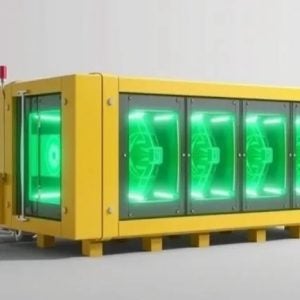
US utilities, Exelon and American Electric Power (AEP) are objecting to Talen Energy Corporation’s plans to supply power to an Amazon Web Services (AWS) data centre adjacent to Talen’s Susquehanna NPP in northeast Pennsylvania. The utilities, in a filing to the Federal Energy Regulatory Commission (FERC) said the proposed Interconnection Service Agreement (ISA) could result in unfair cost burdens on ratepayers and negatively impact market operations and reliability.
In March, Talen sold its Cumulus data centre campus in Pennsylvania to AWS for $650m including a long-term agreement to provide power from Susquehanna NPP, which currently supplies power to the data centre. Talen will also receive additional revenue from AWS related to sales of Susquehanna’s energy to the grid.
Texas-based Talen is the majority (90%) owner and operator of the Susquehanna plant through its subsidiary, Susquehanna Nuclear. Allegheny Electric owns the other 10%. The plant’s two General Electric boiling water reactors began operation in 1983 and are licensed to operate until 2042 and 2044. In 2022, Talen filed for Chapter 11 bankruptcy as part of a financial restructuring, exiting bankruptcy in 2023. The transaction with AWS is expected to boost to its cash flow. After paying off debts, interest and other costs, Talen expects net proceeds of $361m from the deal.
The Cumulus campus is directly connected to the NPP. The data centre’s four substations have a total potential 960 MW of redundant capacity. This includes 200 MW currently associated with the Nautilus cryptocurrency facility, in which Talen will retain its 75% interest. A further 240 MW of redundant capacity for data centres is expected to be ready this year.
According to Talen Energy’s investor presentation, it will supply fixed-price nuclear power to AWS’s new data centre as it is built. AWS has minimum contractual power commitments increasing in 120 MW increments over several years. AWS has a one-time option to cap commitments at 480 MW and two 10-year extension options tied to nuclear licence renewals.
Exelon and AEP asserted the pending ISA between PJM Interconnection, Susquehanna Nuclear and PPL Utilities would allow the data centre to benefit from the transmission system without paying. Under the ISA, as the co-located data centre would not be classified as “network load” it would not be required to pay PJM transmission fees. PJM is the regional transmission organisation that coordinates the movement of wholesale electricity in all or parts of Delaware, Illinois, Indiana, Kentucky, Maryland, Michigan, New Jersey, North Carolina, Ohio, Pennsylvania, Tennessee, Virginia, West Virginia and the District of Columbia.
Exelon and AEP, in the filing with FERC asked: “How can a load that is synchronised to the transmission system and which might draw power from the transmission system be anything other than Network Load?” Noting previous unplanned outages at the Susquehanna plant that led to unintended power withdrawals from the PJM system, they questioned how such withdrawals would be properly metered and accurately billed.
“The co-located load should not be allowed to operate as a free rider, making use of, and receiving the benefits of, a transmission system paid for by transmission ratepayers,” Exelon and AEP said. “We have no objection to co-location per se, but such load should pay its fair share of system use and other charges, just like other loads and customers.”
Earlier in June, PJM requested FERC’s approval for an amended ISA that would permit Talen to sell 480 MW to the data centre, an increase on the 300 MW under the original ISA, “without a material impact on the Transmission System”. A declaration attached to Exelon and AEP’s protest noted that the original ISA could result in the data centre avoiding transmission costs of up to $140m a year, passing on those costs to PJM customers.
Exelon and AEP argue that, in view of the increasing development of data centres, this case has important implications. It this co-located load is allowed to avoid significant costs, other generators and large consumers might seek similar arrangements.
“Should large quantities of load rush to co-locate with generation on terms that bear even a resemblance to the ISA at issue here, PJM capacity markets will have steadily decreasing volume as the capacity resources flee to serve load that uses and benefits from – but does not pay for – the transmission system and the ancillary services that keep the system running. This will harm existing customers.” Exelon and AEP have asked FERC to set a hearing to address these issues or to reject the ISA, which fails to meet the standards required for non-conforming agreements.
Talen has responded with a statement saying Exelon and AEP’s objections to the Susquehanna ISA “is a misguided attempt to stifle this innovation by interfering with an ISA amendment agreed to and supported by all impacted parties – which Exelon and AEP decidedly are not”.
It noted: “The rapid emergence of artificial intelligence and data centres has fundamentally changed the demand for power and leads to an inflection point for the power industry. Talen’s co-location arrangement with AWS brings one solution to this new demand, on a timeline that serves the customer quickly. We believe powering the data centre economy will require an all-of-the-above approach, which includes both metered and behind-the-meter solutions.”
Talen said: “The factual recitations in the protest are demonstrably false. The legal positions are demonstrably infirm. And nearly all the issues raised by Exelon and AEP are not subject to FERC oversight, because transmission is not implicated. Fundamentally, Talen has the right as a competitive generation company to contract with AWS to sell long-term, committed power. PPL, as the regulated utility that has an actual stake in this ISA, agrees that Talen has the right to sell power directly to AWS and signed an ISA amendment that gives PPL reliability assurances. PJM agrees the ISA is appropriate, and itself filed the application for FERC approval. We will move with dispatch to resolve this matter quickly at FERC.”






